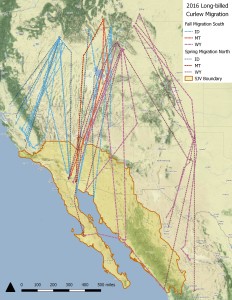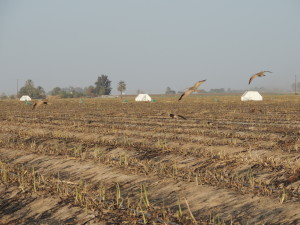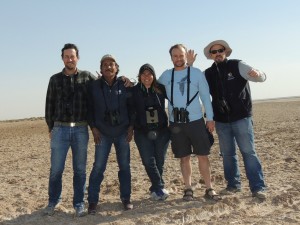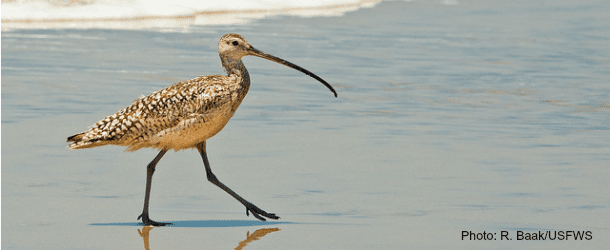By Jay Carlisle, Research Director, Intermountain Bird Observatory at Boise State University

Long-billed Curlew populations are declining in portions of their range, especially in southwestern Idaho. Habitat loss and degradation, along with human disturbance, appear to be the biggest factors. Since 2013, the Intermountain Bird Observatory (IBO) has worked with many partners to track Long-billed Curlews from breeding areas in the Intermountain West to wintering areas in California and Mexico, including locations in the SJV region. By placing satellite transmitters on birds, we have been able to expand our understanding of this species beyond their breeding grounds in Idaho, Montana, and Wyoming. We are learning more about migratory routes, stopover sites during migration, wintering locations, and the habitats curlews use throughout the year.
So far, curlews breeding in the Intermountain West are mostly spending the winters in California’s Central Valley (in the Central Valley Joint Venture) and the Imperial Valley of California as well as in northwestern Mexico (both in the Sonoran Joint Venture). I was thrilled when the SJV Management Board invited me to present IBO’s latest research at their meeting in Baja, California in December 2016. Given the species’ range across the Intermountain West Joint Venture, the Central Valley Joint Venture, and the Sonoran Joint Venture, I was particularly excited to meet with members of the Board and Science Working Group to explore the potential for collaborative curlew research and conservation.

During the meeting, I shared IBO’s findings on the high number of curlews that winter in the SJV region (Figure 1). I also touched on the curlew’s habitat use patterns, which include agricultural, grassland, and intertidal habitats. My presentation inspired more in-depth discussion and exploration of next steps for curlew conservation.
Following the meeting, I had a productive conversation with SJV Board Member Dr. Eduardo Palacios, Research Faculty at CICESE in La Paz, Mexico. We agreed to pursue the idea of co-advising one or more graduate students in the near future to advance our knowledge of habitat preferences and conservation needs of non-breeding curlews. After the SJV meeting I visited San Luis Río Colorado in the lower Colorado River valley in northwestern Sonora to meet several colleagues and explore curlew habitats in the region.

Together with staff from Pronatura, the Mexican National Natural Protected Areas Commission (CONANP), and a graduate student from San Diego State University, we explored agricultural habitats and visited several of Pronatura Noroeste’s habitat restoration projects in the area. By far the best sighting was a group of about 300 Long-billed Curlews in an asparagus field (Figure 2).
The following day we visited several intertidal habitats around Golfo de Santa Clara. Despite being sandblasted by the wind, we saw several concentrations of curlews and other birds (Figure 3). On the way back to town, we stopped at the same asparagus field, which was still supporting hundreds of curlews. We had a quick chat with a couple workers who said they didn’t mind the hordes of curlews because they knew they were eating insects and not damaging the crops.
What are the next steps? I hope to begin a collaboration to better understand habitat and conservation needs of curlews and other birds that use these areas in the Mexicali and Imperial valleys and in intertidal areas. Results from this work could provide management recommendations, both in agricultural and “natural” habitats, that would help curlew conservation efforts throughout their range.

